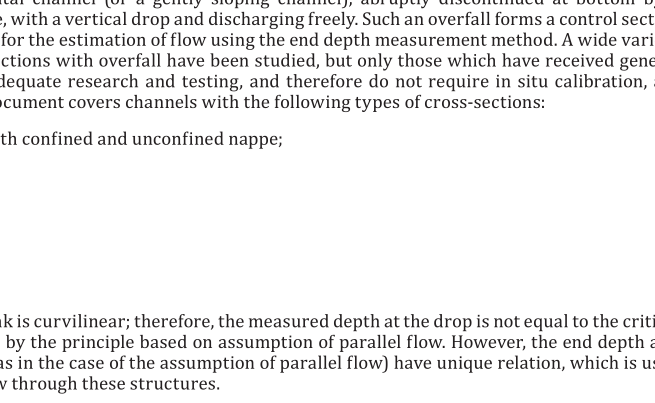ISO 18481:2017 pdf download – Hydrometry — Liquid flow measurement using end depth method in channels with a free overfall.
The flow in the approach channel shall be uniform and steady, with the velocity distribution approximating that in a channel of sufficient length to develop satisfactory flow in smooth, straight channels. Baffles and flow straighteners can be used to simulate satisfactory velocity distribution, but their location with respect to the measuring section shall be not less than the minimum length prescribed for the approach channel. c) The channel bottom should be horizontal. Gentle positive slopes not greater than 1 in 2 000 are admissible; the flow shall be sub-critical, practically uniform upstream of the drop, and the water surface shall be relatively stable and free from perturbations at even during low velocities. d) The side walls, as well as the bottom, shall be smooth as far as possible (in this document, a smooth surface shall correspond to a neat cement finish). The finish of the structure shall be well maintained; changes in wall roughness due to various forms of deposition will change the discharge relationship. e) The end (face) of channel shall be normal to its longitudinal centre line and water shall be allowed to fall freely beyond this point. f) In the case of a confined nappe, the downstream side walls shall be extended to a distance not less than six times the maximum end depth. g) In the case of unconfined nappe, the side walls shall end at the drop and nappe should be completely free at the sides to permit unrestricted spreading. h) The nappe bottom shall be fully aerated in all the cases. 7 Measurement of end depth 7.1 General The end depth is computed by deducting the bed level (gauge datum) from water surface level, both measured at the end or at the fall. The depth shall be measured exactly at the end (drop) of the channel. The flow at the drop is fully curvilinear and any small error in the location of the gauge will result in large error in measurement of discharge. 7.2 Head measuring devices The water surface at the fall or end may be measured using a point gauge or other suitable measuring device. The pointer shall be at the centre of the channel width. The use of hook gauge or any other measuring device requiring insertion inside water is not advised and is discouraged. The flow would drag the pointer and displace it away from the point of measurement or the pointer will vibrate leading to inaccurate measurement. The device selected should not disturb the flow conditions at the free fall. Stilling well or float well cannot be used for the measurement of the end depth. 7.3 Gauge datum Accuracy of end depth measurement is critically dependent upon the determination of the gauge datum or gauge zero, which is defined as the gauge reading corresponding to the channel bed (bottom) at the end (drop) in case of rectangular or trapezoidal channels, or the lowest point of the triangular or circular channel at the end (drop).
ISO 18481:2017 pdf download – Hydrometry — Liquid flow measurement using end depth method in channels with a free overfall





